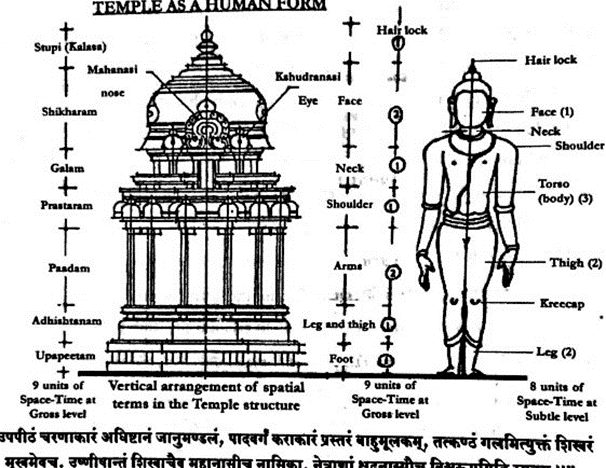CHENNAI, INDIA, January 21, 2024 (HPI): With the controversy over the Ayodhya Ram temple prana pratishta, installation of the main Deity, Hinduism Today sought the view of Selvanathan Sthapati, one of South India’s most highly regarded temple architects. He said there was no merit to the view that the entire temple necessarily had to be completely finished before the installation. Indeed, he wrote, this has rarely been the case for either ancient and modern temples. His explanation is that the central sanctum and vimana tower over it is itself a form of God and once finished, begins to channel divine energy before the physical image of the God is installed. Therefore, it is not only allowed, but advisable that the central image be installed as soon as the sanctum and vimana are complete, as was the case at the Ayodhya Ram temple, or even beforehand.
The following is his detailed and technical explanation:
In the past when magnificent temples were built, their presiding Deities, huge in size, were installed even well before the completion of the garbhagriham (central sanctum, literally “womb chamber”) and vimanam (tower over the central sanctum). In the present context, most of the temples in the United States perform prana prathistai (“establishment of the image in its vital breath,” meaning bringing the Deity to life) before the completion of the indianisation works for the Garbhagriham and vimanam for various reasons.
As far as Ayodhya Sri Rama Temple is concerned, when the central sanctum with vimanam is completed then the moola vigrahas (main Deities) can be installed and mahabhisekam (“great bath,” marking the commencement of worship) performed ceremoniously. The rest of the construction, such as the various mandapam halls with embellishments and other expansions, can be completed in due course.
As per shastraic concept, a temple is a Vishwaroopa (universal form) of the Lord himself. To demonstrate this notion Shilpi experts designed the temple structure correlating to human limbs thereby addressing it Praasada Purusha–“building person,” meaning the temple itself is considered a form of God.
This concept is illustrated in the standing and reclining forms of a Temple and a Purusha or person (drawing at top). In other words, when a free space is enclosed within four walls, it becomes an energy-infused building. The energy particles dwelling inside the building become the divine spirit. Consequently, the building vibrates and becomes a living organism. This is the transformation of subtle into gross that is Sukshmam into sthulam.
In one of the shilpa text which guide temple construction, Sirparatnam’s verses endorse to the above statement as “prasadam purusham mathva pujayet mantra vittamaha,” meaning that the priest well versed in mantras looks upon the Praasadam, the sacred built form, as the divine Purushan (God) and worships Him with due respect. This was the sole reason for the priests to anoint the vimana kalasam (decorative pot at top of the tower over the central sanctum) first during the consecration ceremony with the holy water carried from the yagasaala (place where fire ceremonies are conducted adjacent to the temple during the dedication) and then the mahabhisekam (“great bath” with blessed water) to the presiding deity in the sanctum.
Among the shilpa texts – Manasaara shastra mentions that, “ Vimanam sthula lingam cha, sukshma lingam sathasivam,” meaning that Garbhagruham with Vimanam is not the “home of God” but but an actual “form of God.” The Lingam inside the garbhagruham is the subtle form called Sukshma Lingam (subtle form) and the vimanam covering the garbhagriham is the Sthula Lingam (gross form). So here Lingam is meant to be the Shiva Lingam or any prime Deity housed within the sanctum sanctorum. In the case of Ayodhya, that is Sri Ram.
For better understanding, the doyen master temple builder, the late Padmabhushan Dr. V. Ganapati Sthapati explained the sloka by saying as, “Vimana sthula bimbam (form) cha Sukshma dhuruva (moola) beram (main deity).” It means that the main Deity is the sukshma form and the vimanam is the sthula form.
There is a verse from Makutagama stating that Deities fashioned in accordance with shastric measures will automatically emit the divine energy. This is applied to all the sacred structures when built in accordance with the prescribed measure, proportions and aesthetics as cited in shilpa shastra- the divine energy will automatically permeate well before the consecration.
Therefore, the presiding deity can always be installed to imbue the spread-energy from the sanctum sanctorum and bestow spiritual bliss and physical welfare to all its devotees and visitors standing in front of the garbhagriha.
Strikingly, all our ancient temple complexes covering a larger span of time were built stage wise during various epochs. Tamil Nadu’s age-old temples were first built with the garbhagriha and vimanam and the moola beram (main deity) was then installed ritually for worship. Later on, during the course of time, the rest of the expansions like artistic mandapams with ornate pillars, auxiliary shrines or parivaralayas , high towers or gopurams, multiple halls and walkways were constructed by various monarchies in different time periods.
Based on the above, the Sri Rama vigraha carved in accordance with the shastraic measures and form will resonate with the temple form after the ceremonious prana prathistai.

